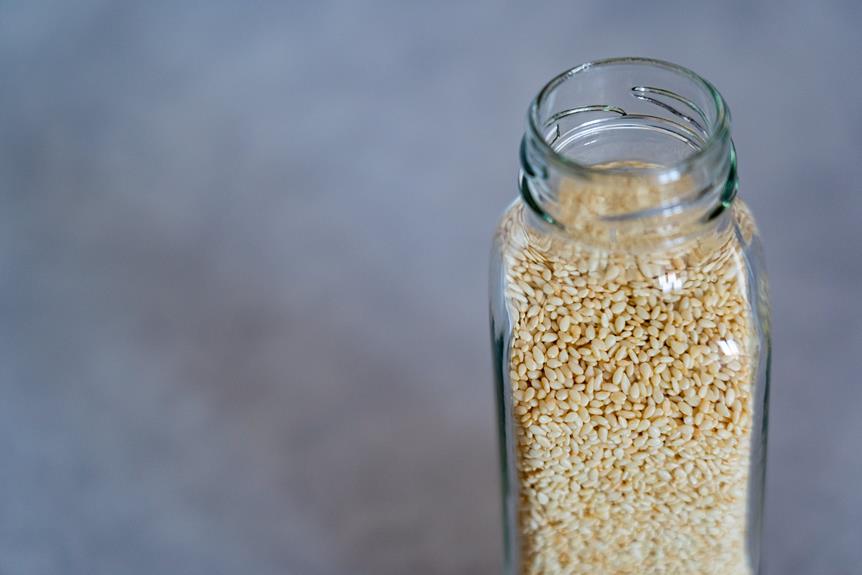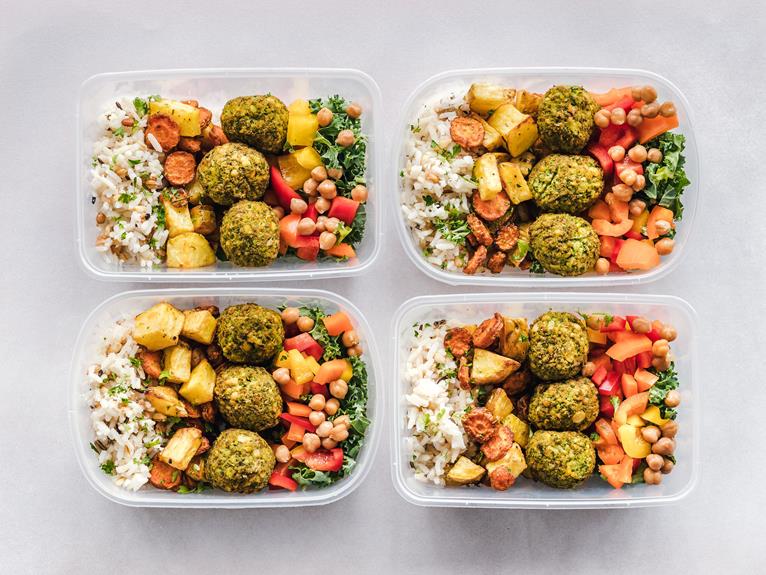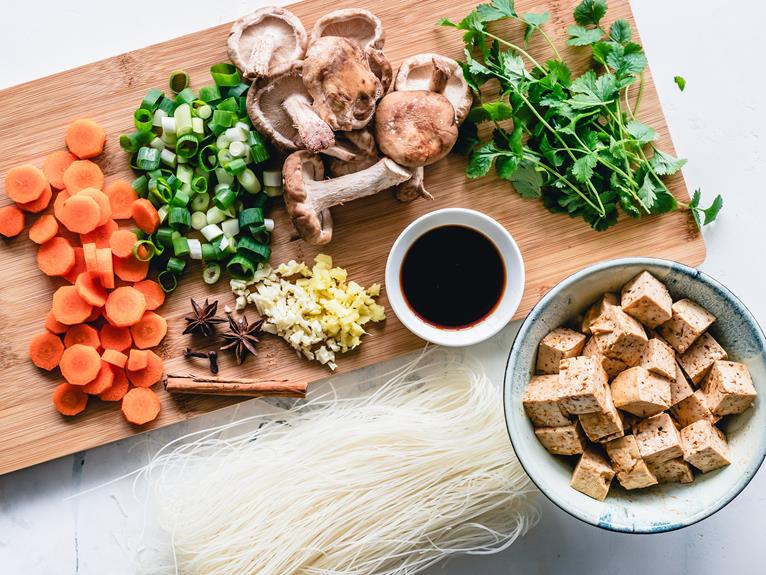Cooking with homegrown produce may seem simple, but it actually requires finesse to truly maximize the flavor. To take your homegrown meals to the next level, consider these 13 invaluable tips.
First, choose the freshest produce possible. Harvesting at peak ripeness ensures optimal flavor.
Additionally, experiment with fermentation techniques like pickling or making sauerkraut. These methods can enhance the taste and provide unique flavors.
When cooking with homegrown produce, keep it simple. Let the natural flavors shine through by using minimal ingredients and seasonings. Avoid overcomplicating dishes and overpowering the taste of the fresh produce.
To add depth to your dishes, try incorporating herbs and spices that complement the flavors of your homegrown produce. For example, if you're cooking with tomatoes, basil and oregano are great choices.
Don't be afraid to get creative with your cooking methods. Grilling, roasting, or even smoking your homegrown produce can add a smoky and charred flavor that elevates the dish.
It's also important to consider the texture of your homegrown produce. Incorporate a variety of textures, such as crispy, crunchy, or creamy, to create a more enjoyable eating experience.
Pair your homegrown produce with high-quality ingredients. For example, if you're making a salad with homegrown lettuce, use a flavorful dressing and top it off with some freshly grated Parmesan cheese.
When serving your homegrown produce, presentation matters. Take the time to arrange your dishes in an appealing and appetizing manner. This can enhance the overall dining experience and make your meals even more enjoyable.
Lastly, don't forget to taste as you go. Adjust seasonings and flavors as needed to ensure that your homegrown produce is the star of the dish.
By following these tips and tricks, you can transform your homegrown produce into culinary masterpieces that will impress your taste buds. So get cooking and enjoy the flavorful fruits (and vegetables) of your labor!
Choosing the Freshest Produce
When you're choosing the freshest produce, trust your senses and look for signs of quality. It's important to pick the best fruits and vegetables for a successful cooking experience with homegrown produce.
Start by examining their appearance. Look for vibrant colors, firm texture, and smooth skin. Avoid any fruits or vegetables that have bruises, blemishes, or signs of decay.
Next, give them a gentle squeeze. The produce should feel firm but not too hard. If it feels too soft or mushy, it may be overripe.
Also, take a moment to smell the produce. It should have a pleasant, fresh aroma. If it smells off or sour, it's best to pass on it.
Once you've chosen the best produce, store them properly to maintain their freshness. Keep them in the refrigerator in the designated compartments or in a cool, dark place. Some produce, like tomatoes and avocados, are best stored at room temperature until they ripen.
Harvesting at Peak Ripeness
To ensure the best flavor and quality in your homegrown produce, it's important to harvest your fruits and vegetables when they're at their peak ripeness. Harvesting at the right time is crucial for maximum flavor and nutritional value.
But how do you know when it's the right time to pick your produce? Look for ripeness indicators such as color, texture, and aroma. For example, a ripe tomato should be a vibrant red color, have a firm yet slightly soft texture, and emit a strong, sweet smell. On the other hand, an unripe tomato will be pale green and hard to the touch.
When it comes to harvesting methods, it's important to handle the produce gently. Use a sharp knife or shears to cut the fruits and vegetables from the plant, being careful to avoid any damage to the stem or surrounding area. Make sure not to squeeze or drop the produce, as this can cause bruising and spoilage.
Proper Storage Techniques
Once you've harvested your homegrown produce at peak ripeness, it's important to learn proper storage techniques to maintain their flavor and quality. Proper storage techniques not only prevent spoilage but also ensure that you can enjoy your hard-earned produce for longer.
Here are three important tips to help you store your homegrown produce effectively:
- Temperature control: Different fruits and vegetables have different temperature requirements. Storing them at the right temperature can significantly extend their shelf life. For example, leafy greens and herbs prefer cooler temperatures, while root vegetables like carrots and potatoes thrive in a slightly warmer environment. Storing your produce at the optimal temperature prevents premature spoilage and retains their freshness.
- Humidity levels: Moisture control is crucial when it comes to proper storage. Some fruits and vegetables, like tomatoes and cucumbers, prefer higher humidity levels, while others, such as onions and garlic, need a drier environment. By storing your produce in the right humidity, you prevent mold and rot, ensuring that they stay fresh and flavorful.
- Air circulation: Proper airflow is essential to prevent the buildup of ethylene gas, a natural plant hormone that accelerates ripening. Avoid overcrowding your produce and allow for adequate air circulation between them. This helps maintain their quality and prevents spoilage.
Enhancing Flavor With Herbs and Spices
Enhancing the flavor of your homegrown produce is easy with the vibrant and aromatic combination of herbs and spices. Adding these flavorful ingredients to your dishes can elevate the taste of your home-cooked meals and create a sense of belonging in your kitchen.
One way to enhance the flavor of your homegrown produce is by using marinades. Marinades infuse your vegetables with herbs and spices, allowing them to absorb the flavors and become more flavorful. Try marinating your vegetables in a mixture of olive oil, garlic, rosemary, and lemon juice before grilling or roasting them for a delicious and fragrant dish.
Another way to enhance the flavor of your homegrown produce is by pairing herbs and spices. Different herbs and spices complement each other and bring out the best flavors in your vegetables. For example, pairing basil with tomatoes or mint with peas can create a harmonious combination that will make your taste buds sing. Experiment with different herb and spice pairings to find your favorite flavor combinations.
To help you get started, here is a table showcasing some popular herbs and spices and the vegetables they pair well with:
- Rosemary: Potatoes
- Thyme: Carrots
- Cilantro: Tomatoes
Incorporating Homegrown Veggies Into Salads
Let's discuss how you can incorporate the delicious flavors of your homegrown produce into refreshing salads. Salads are a fantastic way to showcase the freshness and vibrancy of your vegetables. Here are three simple ways to make your salads even more flavorful and satisfying:
- Mix it up: Try different combinations of homegrown veggies to create a variety of flavors and textures. Add crisp lettuce leaves, juicy tomatoes, crunchy cucumbers, and colorful bell peppers for a vibrant and refreshing salad. Don't forget to include fresh herbs like basil or cilantro to elevate the taste.
- Get creative with dressings: Make a homemade dressing using your homegrown herbs and spices. Blend fresh basil, garlic, olive oil, lemon juice, and a pinch of salt and pepper for a tangy and aromatic dressing. Alternatively, try a creamy avocado dressing made with ripe avocados, lime juice, and a dash of chili powder for a zesty kick.
- Add some protein: Make your salad more filling by incorporating protein-rich ingredients. Toss in grilled chicken or shrimp for a satisfying meal. If you prefer a vegetarian option, sprinkle some roasted chickpeas or toasted nuts. The protein won't only add flavor but also keep you feeling satisfied for longer.
Creating Delicious Homemade Salsas
Creating Homemade Salsas: Elevating the Flavors of Your Garden Produce
Why not try making your own delicious homemade salsas to enhance the flavors of your homegrown produce? Salsas are a versatile and flavorful way to showcase the vibrant taste of your garden-fresh ingredients. Whether you prefer a mild and tangy salsa or a fiery and spicy one, there are countless variations to suit your taste.
Here are a few ideas to get you started:
- Classic Tomato Salsa: Made with tomatoes, onions, jalapenos, cilantro, and lime juice.
- Mango Salsa: Combining mangoes, red onions, jalapenos, lime juice, and cilantro.
- Roasted Corn and Black Bean Salsa: Featuring corn, black beans, red bell pepper, red onion, lime juice, and cilantro.
Pairing your homemade salsa with the right dishes can take them to the next level. Consider these salsa pairing ideas:
- Serve classic tomato salsa with grilled chicken or fish for a refreshing and tangy kick.
- Mango salsa pairs beautifully with grilled shrimp or as a topping for fish tacos.
- The smoky flavors of roasted corn and black bean salsa are perfect for adding depth to grilled meats or as a topping for tacos.
Experiment with different ingredients and spice levels to create your own signature homemade salsa. Your friends and family will keep coming back for more.
Enjoy the vibrant flavors and the satisfaction of creating something delicious from your homegrown produce.
Preserving the Taste Through Canning
Preserve the vibrant flavors of your homemade salsas by canning them, ensuring that you can enjoy the taste of your garden produce all year round. Canning offers several benefits that will keep your salsa tasting fresh and delicious.
Here are three reasons why canning is the ideal method for preserving your homemade salsas:
- Longer shelf life: Canning allows you to extend the life of your salsas by sealing them in airtight jars. This prevents spoilage and maintains the flavors for months, so you can savor the taste of your garden produce long after the harvest season.
- Retains freshness: Unlike other preservation methods, canning locks in the taste and texture of your salsas. The high heat used in the canning process helps preserve the vibrant colors, flavors, and nutrients of your homemade creations, ensuring that each jar tastes as good as the day you made it.
- Convenience and accessibility: Canned salsas are easy to store and transport. They take up less space in your pantry compared to freezing or drying methods. Plus, they're readily available whenever you crave that burst of flavor, making it a convenient option for busy individuals or those seeking quick and easy meals.
Infusing Oils and Vinegars With Fresh Herbs
Enhance the flavors of your dishes by infusing oils and vinegars with fresh herbs. Infusing oils and vinegars with fresh herbs not only adds unique flavor combinations to your cooking but also provides various health benefits.
By infusing oils with herbs like rosemary, thyme, or basil, you can create flavorful concoctions that elevate the taste of your favorite dishes. Imagine drizzling a homemade rosemary-infused olive oil over a salad or using a thyme-infused oil to roast your vegetables – the possibilities are endless.
Infusing vinegars with fresh herbs can also elevate your culinary creations. Whether it's a basil-infused balsamic vinegar dressing for your Caprese salad or a mint-infused vinegar to splash over fresh fruit, the infusion process adds depth and complexity to your recipes.
Not only do herb-infused oils and vinegars enhance the taste of your dishes, but they also offer health benefits. Herbs are known for their antioxidant properties and can provide additional nutrients to your meals. So, not only will you be adding delicious flavors, but you'll also be boosting the nutritional value of your dishes.
Infusing oils and vinegars with fresh herbs is a simple and rewarding way to bring a touch of freshness and flavor to your cooking. Experiment with different herb combinations and discover your favorite flavor profiles. Your dishes will taste more vibrant and inviting than ever before.
Freezing Techniques for Long-Term Use
Preserving the flavors of your homegrown produce through freezing is a fantastic way to enjoy them year-round. To make the most of your harvest, here are three freezing tips:
- Blanch before freezing: Blanching helps maintain the color, texture, and flavor of your fruits and vegetables. Simply blanch them in boiling water briefly, then transfer to an ice bath to stop the cooking process. Once cooled, pack them into airtight, moisture-resistant freezer-safe bags or containers.
- Use proper packaging: To prevent freezer burn and preserve flavor, choose freezer-safe bags or containers that are airtight and moisture-resistant. Label them with the name and date for easy identification.
- Consider portion sizes: Freezing your produce in smaller portions makes it easier to thaw and use what you need. This way, you won't have to defrost the entire package if you only need a small amount for a recipe.
By following these tips, you can ensure that your frozen produce retains its quality and flavor for long-term use.
Enjoy the taste of your homegrown goodness all year round!
Grilling Techniques for Maximum Flavor
Grilling Techniques for Delicious Flavor
To achieve maximum flavor when grilling, it's important to use the right techniques and methods. Grilling is an art that requires finesse and attention to detail. Whether you're a seasoned griller or just starting out, these grilling tips will help you elevate your grill game and create mouthwatering dishes that will keep your family and friends coming back for more.
One of the secrets to flavorful grilled food is marinating. A good marinade can enhance the taste and tenderness of your meat, poultry, or vegetables. Here are three simple marinade recipes to try:
- Tangy Citrus Marinade:
Mix orange juice, lemon juice, and garlic in a bowl. Pour the mixture over the meat and let it marinate for at least 1 hour.
- Spicy Teriyaki Marinade:
Combine soy sauce, ginger, honey, and chili in a saucepan. Simmer the mixture for 5 minutes, then let it cool before marinating.
- Herb-infused Marinade:
Crush garlic and mix it with olive oil and rosemary. Rub the mixture onto the meat and let it sit.
These marinades will infuse your food with incredible flavor. Remember to give yourself enough time to marinate for the best results.
Happy grilling!
Baking With Homegrown Fruits
Get ready to tantalize your taste buds with delicious baked treats made from the fresh fruits you've grown in your own garden. There's nothing quite like indulging in fruit desserts made with the fruits you've nurtured and harvested yourself. Here are three tips to help you make the most out of your homegrown fruits when baking:
- Choose the ripest fruits: The flavor and sweetness of the fruit are key when it comes to fruit desserts. Pick your fruits when they're at their peak ripeness, bursting with natural sugars and their flavors at their best. This will ensure that your pies and other baked goods have a truly delightful taste.
- Experiment with different combinations: Don't be afraid to mix and match different fruits in your recipes. Combine tangy berries with sweet peaches or tart apples with juicy pears. The possibilities are endless, and by mixing flavors, you can create unique and exciting fruit desserts that showcase the best of your homegrown produce.
- Embrace the seasons: Take advantage of the seasons to create delicious pies that highlight the flavors of each time of year. Use fresh berries in the summer, crisp apples in the fall, or citrus fruits in the winter. By using fruits that are in season, you'll enhance the flavors of your baked goods and ensure that they're at their peak freshness.
With these tips in mind, you can create mouthwatering fruit desserts and seasonal pies that will have your friends and family begging for more. So get baking and enjoy the fruits of your labor in the most delicious way possible.
Creating Flavorful Soups and Stews
Enjoy delicious and comforting soups and stews made with the abundance of fresh produce from your garden. There's something truly satisfying about indulging in a warm bowl of soup or stew, especially when it's made with ingredients you've nurtured and grown yourself. To enhance the flavors of your creations, try incorporating flavorful pasta dishes and utilizing roasting techniques.
When it comes to soups and stews, pasta can add a delightful texture and taste. Experiment with different types of pasta, like penne, fusilli, or tortellini, to add variety to your dishes. These small bites of pasta will soak up the flavors of the broth and vegetables, making each spoonful even more delicious.
Roasting your homegrown vegetables before adding them to your soups and stews can also elevate their flavors. This technique caramelizes the natural sugars in the vegetables, intensifying their taste and adding depth to your dish. Simply toss your vegetables in olive oil, sprinkle with salt and pepper, and roast them in the oven until they become tender and slightly browned. Then, add them to your simmering pot of soup or stew for an explosion of flavor.
Experimenting With Fermentation Techniques
Expand Your Culinary Horizons with Fermentation Techniques
Discover the world of fermentation and take your homegrown produce to new heights of flavor and complexity. Fermentation isn't only a time-honored preservation method, but it also offers a plethora of benefits that can elevate your dishes.
Here are three compelling reasons why you should give fermentation techniques a try:
- Enhanced Flavor: Through fermentation, the natural flavors of your homegrown produce are brought to the forefront, creating a depth and complexity that can't be achieved through other cooking methods. This process releases enzymes that break down complex molecules, resulting in unique and delicious flavors that will tantalize your taste buds.
- Increased Nutritional Value: Fermented foods are packed with probiotics, which are beneficial bacteria that promote a healthy gut. By incorporating fermented produce into your meals, you can boost your digestive health and improve nutrient absorption, leading to a happier and healthier you.
- Versatile Recipes: From tangy sauerkraut and spicy kimchi to zesty pickles and refreshing kombucha, the world of fermentation offers a wide array of recipes waiting to be explored. With endless possibilities for flavors, spices, and textures, you can create personalized dishes that reflect your unique taste preferences and culinary style.
Conclusion
So there you have it, folks! By following these tips and techniques, you can elevate the flavor of your homegrown produce.
Start by using fresh herbs and spices to enhance the taste of your dishes. Instead of relying on clichés or overused phrases, let your creativity shine through.
Grilling and baking with your own fruits and veggies adds a delicious twist to your meals. To take it even further, you can experiment with fermentation techniques for a unique flavor profile.
Don't be afraid to try new things and wow your taste buds. Impress your guests with the deliciousness of your homegrown creations.
Let your garden be the gift that keeps on giving!

















